THE average layman knows of but two great native civilizations in America, those of the Aztecs and of the Incas. This is, of course, because his reading upon this subject has been limited to Prescott’s entrancing histories of the conquests of these two empires. Even the magnificent Maya culture, the highest of all, is but little known to him. However, from central Mexico to northern Chile and Argentina existed other high civilizations, most often related culturally to the two great nations, some of them vassals of the Aztec or Inca empires, but generally quite different in language and divergent in culture. And before all of these, earlier nations and cultures had existed which left the record of their progress beneath the soil.
One of these lesser cultures was that of the Zapotec in the State of Oaxaca in southern Mexico. Entirely different from the Aztec and their predecessors, the Toltec, in language and in most phases of culture, they existed as an independent nation until about the year 1495, when they were conquered and became subject to the Aztec empire.
Their territory lying in southern Mexico, between the two great centers of culture, that of the Toltec in the Valley of Mexico and that of the Maya in Guatemala and Yucatan, the Zapotec could not have escaped absorbing cultural elements of both of these nations, and their civilization attained a high grade. Their work in gold, copper, jade, stone and pottery was among the best in Mexico, their pyramids and other structures were immense and imposing, and they possessed a system of writing, or at any rate of recording calendrical dates. On the whole, their civilization was somewhat closer to that of the Maya than to that of the Toltec and Aztec.
The most typical Zapotec objects are the funerary urns of pottery which were buried in or around tombs. These tombs are in themselves admirable structures, generally consisting of a chamber with walls and roof of stone and adobe, cement floor and a doorway with a great stone lintel, all carefully carved and faced. In these were laid the bodies of the illustrious dead, and usually a great mound of earth was heaped over the tombs, these mounds being today known as mogotes.
The funerary urns found with these tombs were never placed in the chamber itself, but generally above the lintel of the door, on the roof, on the floor in front of the door, fastened in the façade, placed in niches over the door, or in other similar places. They are generally found in groups of five. Though they almost invariably possess a cylindrical cavity, the purpose of which must have been to contain some material, yet they are always found empty and no clue as to their use is known. It is possible that they contained water for the dead; on the other hand, religious conservatism might have caused the continuation of their form long after their utilitarian employment had been discontinued and their purpose forgotten.
The urns are very typical and unmistakable, both as regards form and ornament. They are always made of a dark, heavy, hard and rather thick pottery, unpainted except for washes of color in places, and generally covered with a thin slip of stucco. Always ornate and exotic in appearance they are frequently large as well.
By far the greater number of these urns consists of human figures with very ornate decorations, especially in the headdresses. They are generally shown as seated, less often standing. Animal figures are rare, although anthropomorphic figures with animal heads are not infrequent, but animal figures with human heads seem to be never found. Apparently the faces and the low relief ornamentation were generally made in moulds.
The UNIVERSITY MUSEUM now possesses about forty of these urns, the majority of them forming part of a large collection recently acquired by purchase. Eleven of the finest and most unusual are shown on these pages. They are of exceptional quality and therefore cannot be said to be representative of the average Zapotec urn, nor of those in the MUSEUM’S collection. The most typical of these is that shown on page 195. The common type of urn consists of a human figure sitting crosslegged with the large hands resting on the knees; the legs and feet are somewhat conventionalized. The body is clothed and ornately decorated with an elaborate headdress, breast ornament, and great discoidal ear ornaments. The face is naturalistic, sometimes so much so that it is believed that many of the urns are portraits of the deceased, but frequently the human face is obscured by a great mask covering the nose and frequently the mouth and eyes. The nose of the mask is generally very large and protruding, the eyes often rectangular. Analogies between the characteristics of the mask and those of certain Mexican and Mayan gods can often be traced. The back of the figure is generally composed of a cylindrical vase, the round mouth being at the level of the neck, but in some cases the head itself is cylindrical with the orifice at the top.
Animal figures such as those shown on pages 181 and 183 are practically unique, and standing figures such as those on pages 185, 187 and 189 extremely rare. Figures on pyramids such as that on page 193 are unusual, as are those on bases like that on page 191. The remarkably pictorial head and the animal headcovering of the urn shown on page 199 are quite unique, and the bodyless type such as that on page 201 is out of the ordinary. Most of these, moreover, are of unusual size and degree of ornamentation. None of them, however, shows the elaborate face mask which is characteristic of many of these urns.
While many of the urns in the MUSEUM collection are of the most typical class, a few others not shown in this article deserve special mention. In two instances, the figures are seated on a raised support, the lower legs being vertical. In all such cases where the legs are shown thus, the feet are carefully moulded and the sandal cords may be seen; this is not the case with the cross-legged figures. Another figure is seated on a high box base and another on a square base, both with feet flat on the ground. One very naturalistic figure with little ornamentation and no headdress or breast ornament sits cross-legged on the ground, a small opening in the top of the head taking the place of the ordinary posterior cylindrical vase. Another unique small figure wears a most ornate mask with bits of copper in the eyes, and behind the usual vase is a small altar or niche.
The Pottery Urns
Composite Bat-Dog Figure
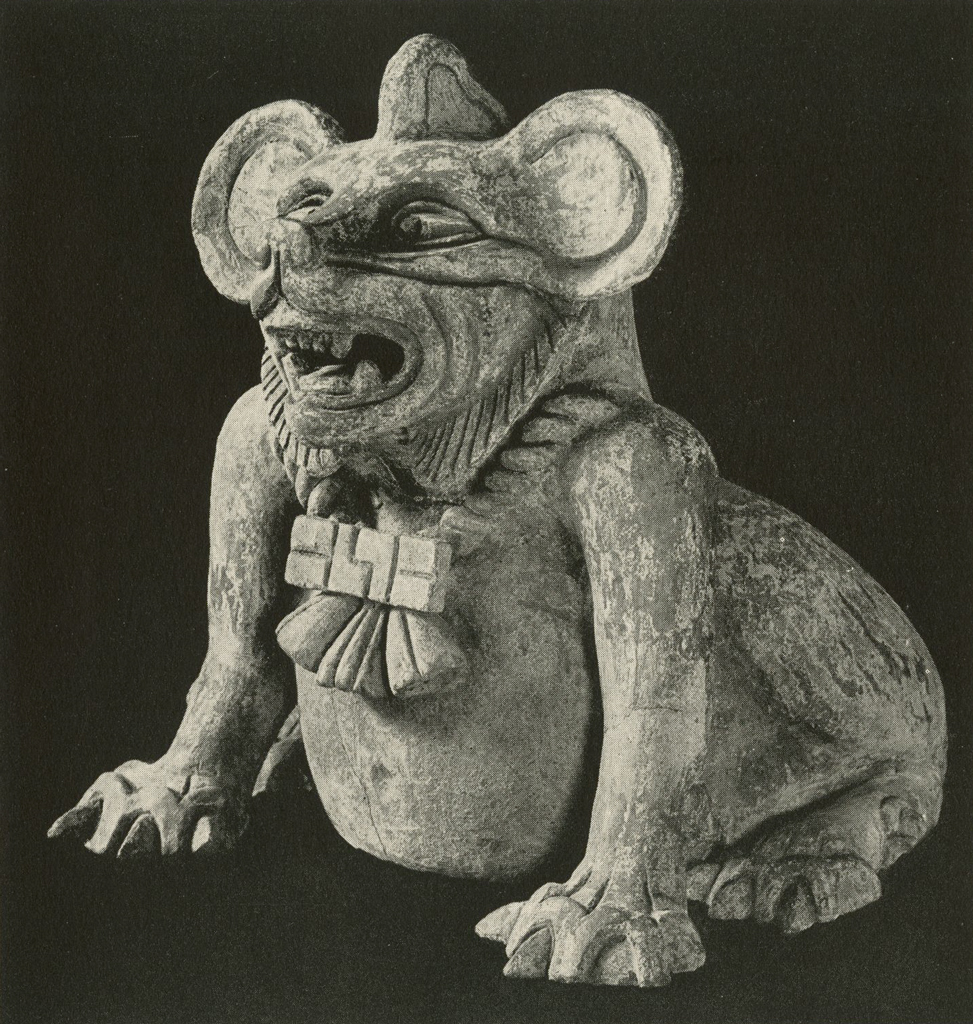
Image Number: 19929
This and the companion figure shown on the following plate are probably the most remarkable pottery figures ever found in the Zapotec region. Only one other pair of the type is known, and these are much smaller and are said to have been found at a place near that where those here described were discovered.
The head with its great ears, peculiar nose, teeth and facial expression, mane and beard and the large belly with prominent navel are very bat-like in character. The limbs and claws are those of another animal. The posture is dog-like, as are the toes, and it is altogether likely that this animal was intended to be represented. The Indians who found these specimens considered them as the “Messenger Dogs of the Gods”, the larger male, the smaller female.
Both of these animal figures were found in a cave temple facing each other near a niche for the figure of the principal deity, which figure was missing. A landslide had covered the entrance to the cave, the existence of which was known only by the oral tradition of the Indians of the surrounding region.
Found at Guilá, Oaxaca, Mexico. Height 19½ inches.
Composite Animal Figure

Image Number: 19931
The companion piece to the preceding, most of the comments upon which also apply to this.
The Bat God was one of the important deities of the Maya, many elements of whose religion were shared also by the Zapotec. The Bat God in particular is known to have been revered also by the Zapotec, hut was not recognized by the Toltec and Aztec of the Valley of Mexico. He was especially associated, among the Maya at least, with the underworld, and with worship of, and in, caves. It is, therefore, quite natural that bat figures should be encountered in a cave temple. The dog, among the Maya, was considered to be connected with death, and to be the messenger to prepare the way to the hereafter.
These figures are of thick black pottery with hollow interiors. A thin layer of stucco, traces of which still remain, covered the surface. In the back of the neck a large oval orifice affords access to the interior which was probably used for holding some substance as in the case of the usual human figures. The tail is represented by a small semicircular raised ridge along the base of the spine.
Found at Guilá, Oaxaca, Mexico. Height 17½ inches.
Standing Human Figure

Image Number: 19928
A figure of very unusual type, standing upon a rectangular plaque with a supporting brace behind. The material is thick black pottery over which remain traces of a covering of stucco. The hollow body ends with a large oval orifice at the shoulders, above which the head and headdress tower.
The flaring hem of the garment and the ruff around the leg, probably representing the bottom of a leg covering, one of which is missing, are unusual features as are the objects held in the hands. That in the left hand probably represents a weapon or baton, that in the right some esoteric ceremonial object, the nature of which is obscure. The thongs between the toes which bound on the sandals are well portrayed. The omnipresent great discoidal ear ornaments, probably representing obsidian, and the bead necklace, the original probably of jade, are very typical, but the nose pendant, which was presumably of gold, is unusual. The great headdress, the original of which was doubtless made largely of feathers, is less ornate than usual, the eccentric relief face probably representing the owl.
Found in the State of Oaxaca, Mexico. Height 22 inches.
Standing Human Figure
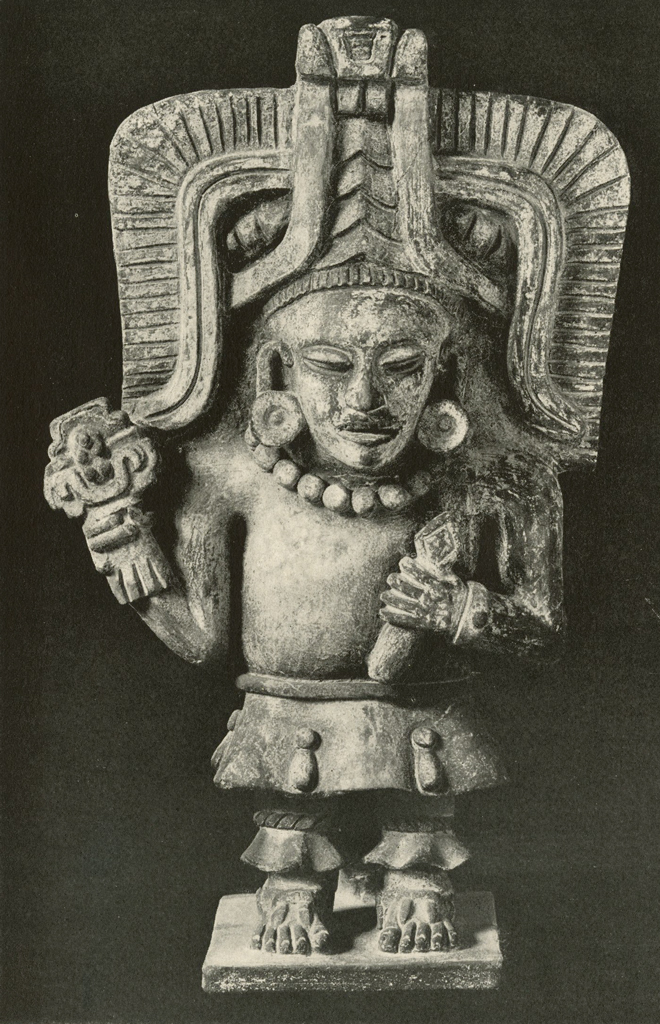
This unusual figure is doubtless a companion piece to the preceding and, with the exception that it lacks the nose pendant and possesses a headdress of different type, the description of the last figure suits this equally well. The objects held in the hands differ only in detail, and are similarly unidentifiable.
The great headdress undoubtedly represents a very conventionalized animal face, the human head appearing beneath the upper jaw, the lower jaw not shown. The artistic concept of a human head framed in an animal’s mouth was a favorite one in Mexico and among the Maya, and numerous examples are known, the jaguar’s, eagle’s and snake’s mouth being the most common. The elongated jaw, the palatal ridges and the merciless eyes in the present instance seem to point to an identification with a crocodile. It appears to be one of the peculiar characteristics of Mexican representations of the crocodile that the lower jaw is never shown.
Found at Tenexpa, Oaxaca, Mexico. Height 21 inches.
Standing Human Figure
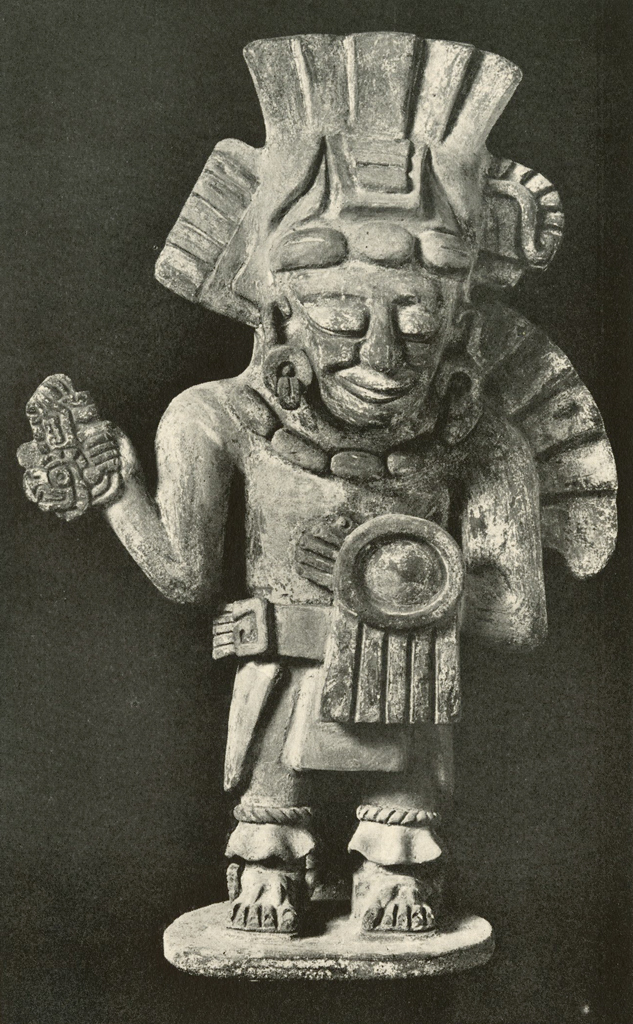
Image Number: 19927
This figure is very similar to the two preceding in general concept, but divergent in many details. The facial expression is very unusual and untypical of Mexican art.
The plaque on which the figure stands is curvilinear instead of rectangular. Although the leg ruffs and the sandal cords are the same as in the preceding figures, the short skirt—or it may be the bottom of a long blouse—is replaced by three other articles of apparel; that to the front is obviously the pendent end of a breech-cloth, those to the sides may be armor pads. The arms are in the same position as in the two preceding figures. The right hand grasps an object of a type similar to those of the preceding figures, but differing in shape; the low relief profile head of a bird, probably an eagle, is an important element in this object. The left hand holds a shield from which hang ornamental tassels. The asymmetrical headdress and the shoulder ornament doubtless represent feathered plumes.
Found in the State of Oaxaca, Mexico. Height 22 inches.
Human Figure Seated Upon A Base

Image Number: 19916
The square base upon which this figure is seated, the sandals and the leg ruffs and cord place it in the same class of unusual figures as the preceding standing ones. Otherwise it conforms more to the common type of Zapotec urns. One hand rests on the knee in the usual position, the other grasps an object, probably a weapon, carved in the form of a fish. The great discoidal ear ornaments, the elaborate headdress and the pendent breast ornament suspended upon a cord, all of them doubtless of exaggerated size, are characteristic of the more typical urns. Traces of red and white wash are evident.
Found at Zaachila, Oaxaca, Mexico. Height 13 inches.
Figure Seated Upon A Pyramid
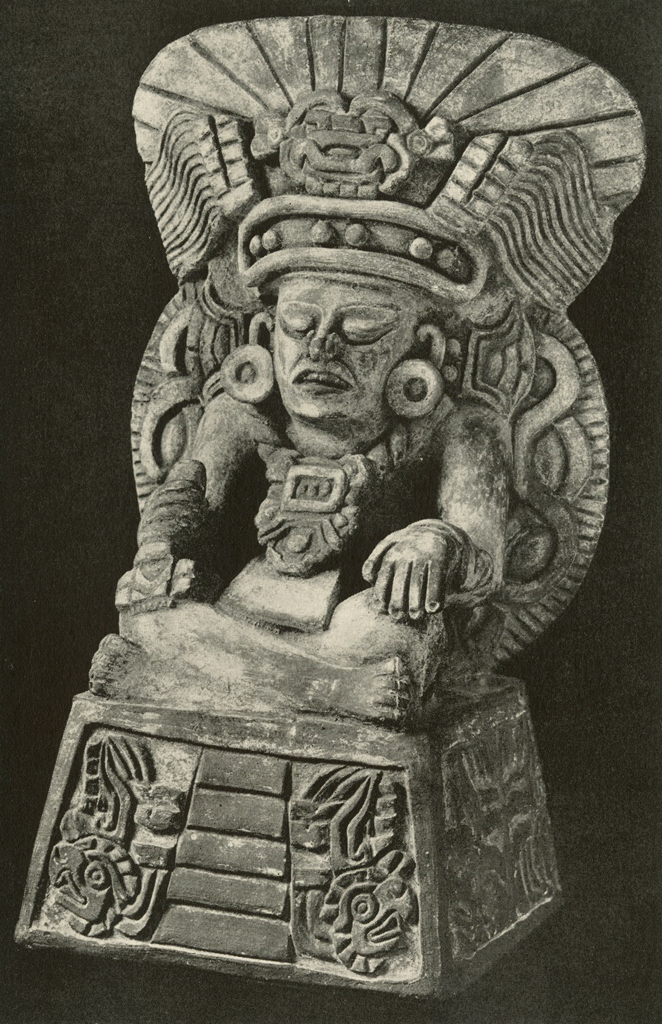
Image Number: 19924
Representations of persons, generally deities, seated upon pyramids, are common in Mexican art. Since the temples in which the gods were worshipped were almost always placed upon truncated pyramids, it is but natural that the small figures of the deity should also often be shown in this position. In this example the steps leading up the front of the pyramid are shown, flanked by conventionalized low relief profile eagle heads and other symbols. The same motifs, without the stairs and with the flanking elements more extended to take the place of the staircase, are shown to the sides of the pyramid, the back being plain. In type of ornamentation and form, this pyramid most resembles the beautiful structure at Xochicalco, near Cuernavaca, Morelos, which, although outside of the Zapotec region, is recognized as showing a blend of Zapotec and of Toltec art.
The figure is seated, cross-legged, in the usual Zapotec style, with the left hand on the knee; the right hand holds a double-bladed axe, probably a weapon. The free front end of the breechcloth, the great discoidal ear ornaments and the breast pendant suspended on a cord are typical of these figures, but the nose plug and the closed eyes are unusual. The headdress, probably representing one composed mainly of flowing plumes, is elaborate but typical, but the great circular background is unique.
The pyramid is covered with a wash of brick red, while a thin wash of white stucco covers most of the figure.
Found in a tomb in the State of Oaxaca, Mexico. Height 18½ inches.
Seated Funerary Urn
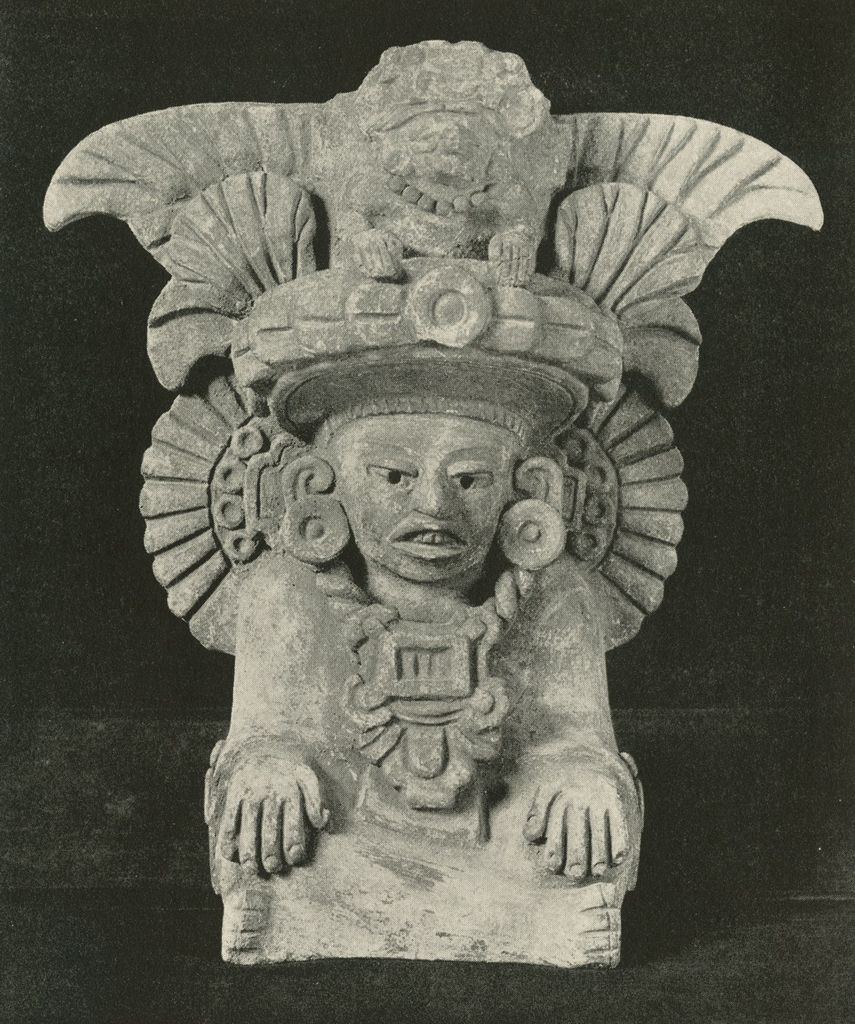
Although rather more ornate and less exotic than most Zapotec funerary urns, this figure is the most typical of that class of all those here shown. The rather conventionalized crossed legs with the large hands resting on the knees, the elaborate headdress, the large ear ornaments and the great breast ornament suspended on a twisted cord are all frequent elements in this art. The large head and neck decorations, the originals of which were doubtless composed mainly of feather plumes, are impressive, the central figure of them representing the bust of a smaller human figure which wears a mask.
Traces of light red and stucco slips remain on the pottery.
Found in a tomb beyond Miahuatlan, Oaxaca, Mexico. Height 15 inches.
Seated Figure Holding Bowl

Image Numbers: 142921, 19917
Except for the bowl which this figure holds before him, a very unusual feature, this specimen typifies best of all the vases shown here the usual Zapotec funerary urn, and displays well the great nose ornament which is frequently found. The position of the legs, the flap of the breech-cloth, the ear ornaments, and the branching headdress are all very typical.
The motif of a human figure holding a bowl before him, which doubtless represents an offering or libation, either as received by the god or offered by the supplicant, is one of wide-spread occurrence in America, being found at least from Mexico to northern Argentina. Nose ornaments in the form of plugs, rings or pendants are also a common element in aboriginal America and extended through the same region. Many of the primitive peoples of South America today wear nose plugs.
Little or no stucco covering is seen on this urn.
Found in a tomb in the district of Etla, Oaxaca, Mexico. Height 16 inches.
Senile Figure with Peccary Head

Image Number: 19925
This small figurine urn is in many respects the most interesting of all here shown and decidedly variant from the usual type of Zapotec vase. The material, the general form, and the position of the legs, hands and breech-cloth, however, leave no doubt as to its origin. Smaller and far less ornate than most, it belongs to the class that is considered as pictorial rather than as representative of deities.
The face is that of an old but active man with wrinkled face and few teeth. Upon his head, in lieu of the usual ornate plumed headdress, he bears an animal’s head which probably represents the peccary. What significance this may have had is problematical. The great ear disks are broken but behind them were large tooth-shaped pendants, one of these also now missing. The necklace of jade beads with the central medallion are common elements, but the short cape covering only the shoulders is unusual. The cylindrical cup which is seen behind is not, as usual, a part of the body, but practically separate and proportionately larger than is normally the case.
Traces of a red wash are visible on the ears and mouth of both human figure and animal head, a light stucco slip over the rest.
Found in a mound tomb at Miahuatlan, Oaxaca, Mexico. Height 11 inches.
Large Bodyless Figurine Urn
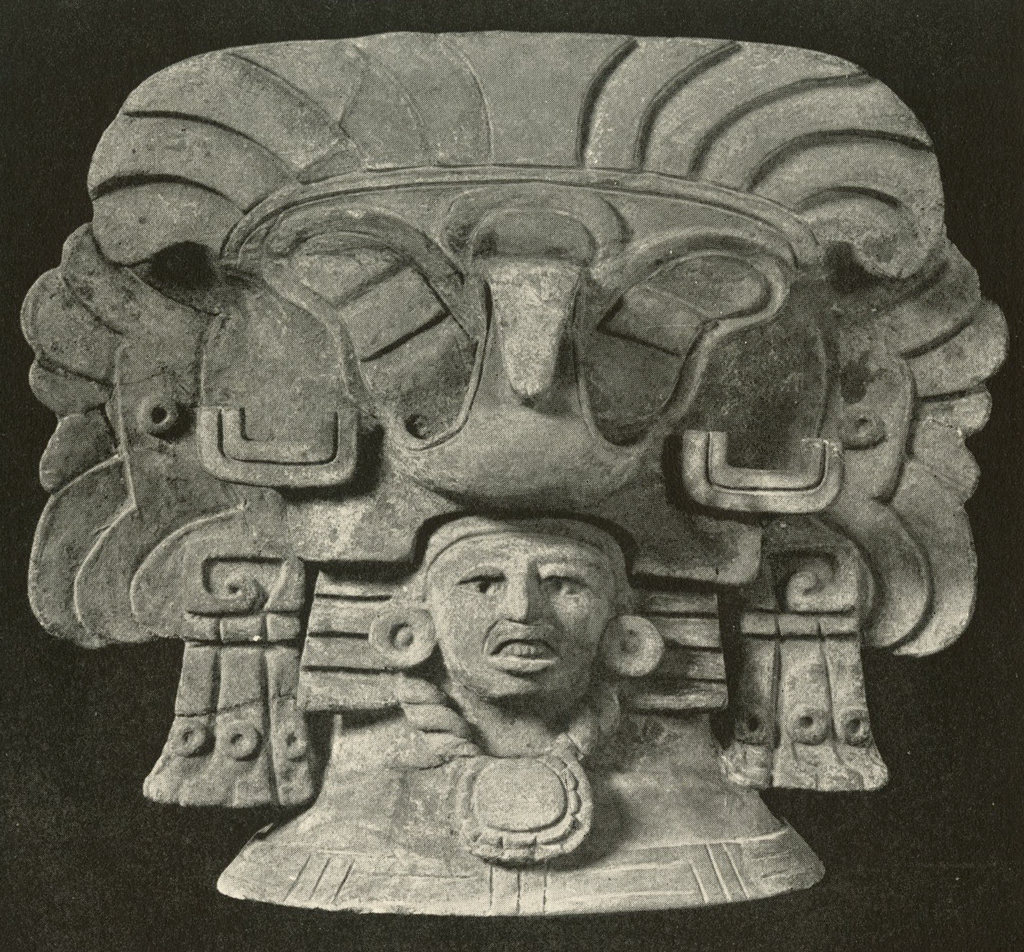
This specimen is the most variant of all those here shown. From the neck up it is of typical Zapotec art, showing the elaborate headdress which was probably composed largely of feather plumes with possibly gold, copper and jade ornaments, the ear disks and the suspended breast ornament. The lower part of the figure, however, is missing and replaced by an oval spreading hollow foot. Behind the ornamental front, the oval vase flares out again above the base, making a vessel of hour-glass or wheat-sheaf shape, with the septum at about the level of the eyes of the human face. The relief ornament above the face resembles a conventionalization of a flying large-billed bird, but this interpretation may be entirely subjective.
The entire vase is covered with a rather thick stucco slip.
Found in a mound tomb at Huitzo, Oaxaca, Mexico. Height 16 inches.

